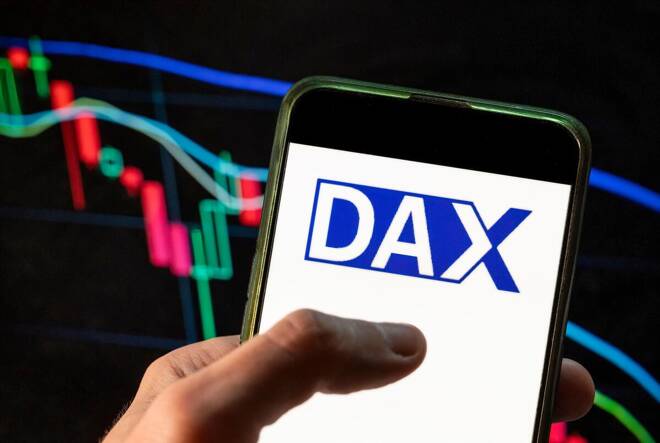Advertisement
Advertisement
DAX Index Today: China Data to Test Dax Momentum Pre-Fed Chair Powell
By:
Key Points:
- The DAX rallied 1.15% on Friday, July 12, closing the session at 18,748.
- On Monday, July 15, GDP numbers from China could affect market risk sentiment.
- Later in the session on Monday, Fed Chair Powell will be in the spotlight.
DAX Rallies on Fed Rate Cut Bets
On Friday, July 12, the DAX rallied 1.15%. Following a 0.69% gain on Thursday, July 11, the DAX closed at 18,748. Investor expectations of ECB and Fed September Fed rate cuts boosted the DAX.
The Friday DAX Market Movers
Tech stocks led the way as investors reacted to economic indicators from Germany and the US. Siemens AG rallied 2.94%, while Infineon Technologies and SAP advanced by 2.22% and 1.22%, respectively.
Auto stocks extended their gains from Thursday. Daimler Truck Holding increased by 1.88%.
German Economic Data: Wholesale Prices Signal Softer Consumer Prices
German wholesale prices fell 0.6% year-on-year in June after declining 0.7% in May.
Wholesale prices are a leading indicator of consumer inflation. Lower wholesale prices may ease demand-driven inflation, supporting a more dovish ECB rate path.
On Monday, July 15, the focus shifted to economic data from China.
China’s Economic Data Reveals Slowdown in Growth
The Chinese economy grew by 4.7% year-on-year in Q2, down from 5.3% in Q1. Slower growth could raise doubts about China meeting its 2024 growth forecast of 5%. A weaker Chinese economy may impact global demand and the German economy.
Nataxis Asia Pacific Chief Economist Alicia Garcia Herrero commented on China’s GDP numbers. She said,
“Nominal GDP growth was only 4%!: Nominal GDP is what matters for debt sustainability which also explains why the room for fiscal policy is narrowing. The PBoC needs to cut rates but today, again, no action on the Medium Term Lending Rate!”
Later in the European session, Eurozone industrial production numbers also need consideration.
Eurozone Industrial Production in Focus
Economists predict Euro area industrial production to fall 1.0% in May after a 0.1% decline in April. However, the stats are unlikely to influence the ECB rate path. The ECB focuses on wage growth, the services sector, and inflation.
While Euro area economic indicators need consideration, the Fed rate path remains crucial.
US Producer Prices and the Fed Rate Path
Headline US producer prices (PPI) increased by 0.2% in June after stalling in May.
However, PPI components that feed into the Personal Consumption Expenditures (PCE) inflation measures indicated a softer inflation outlook.
Capital Economics Chief North America Economist Paul Ashworth commented on the Producer Price Report. He stated,
“The PPI components that feed into the Fed’s preferred PCE deflator inflation measure were significantly lower than expected for June and it looks like May’s PCE gain could be revised down too, albeit only slightly.”
The PPI Report supported investor bets on a September Fed rate cut. According to the CME FedWatch Tool, the chances of a September Fed rate cut increased from 77.7% on Friday, July 5, to 96.3% on Friday, July 12.
The US equity markets responded to the expectations of a possible September Fed rate cut. On Friday, the Nasdaq Composite Index and the Dow saw gains of 0.63% and 0.62%, respectively, while the S&P 500 advanced by 0.55%.
On Monday, the Fed’s reaction to the US consumer and producer price reports requires consideration.
Fed Chair Powell in the Spotlight
Later in the Monday session, Fed Chair Powell is on the calendar to speak. Support for a September Fed rate cut could fuel speculation about a December rate cut. A more dovish Fed rate path would boost demand for DAX-listed stocks.
Near-Term Outlook
Near-term trends for the DAX depend on Euro area inflation numbers (Wed), US retail sales (Tues), and central bank commentary. Lower-than-expected data and support for more dovish ECB and Fed rate paths could send a DAX to 19,000.
On the Futures markets, the DAX was down by 74 points, while the Nasdaq mini gained 52 points.
Investors should remain alert with Fed Chair Powell speaking. Track the news wires, economic data, and expert commentary to manage trading strategies. Stay up-to-date with our latest news and analysis to manage risk.
DAX Technical Indicators
Daily Chart
The DAX sat comfortably above the 50-day and 200-day EMAs, sending bullish price signals.
A DAX break above the 18,750 handle could support a move to the May high of 18,893.
Central bank commentary requires consideration on Monday.
Conversely, a DAX drop below the 18,500 handle could give the bears a run at the 50-day EMA.
The 14-day RSI at 61.70 suggests a DAX return to the May high before entering overbought territory.
4-Hourly Chart
The DAX remained well above the 50-day and 200-day EMAs, affirming the bullish price signals.
A breakout from the 18,750 handle could give the bulls a run at the May high of 18,893.
However, a DAX break below 18,500 may signal a fall toward the 50-day.
The 14-period 4-hour RSI at 70.03 shows the DAX in overbought territory. Selling pressure may intensify at the Friday high of 18,779.
About the Author
Bob Masonauthor
With over 28 years of experience in the financial industry, Bob has worked with various global rating agencies and multinational banks. Currently he is covering currencies, commodities, alternative asset classes and global equities, focusing mostly on European and Asian markets.
Advertisement
